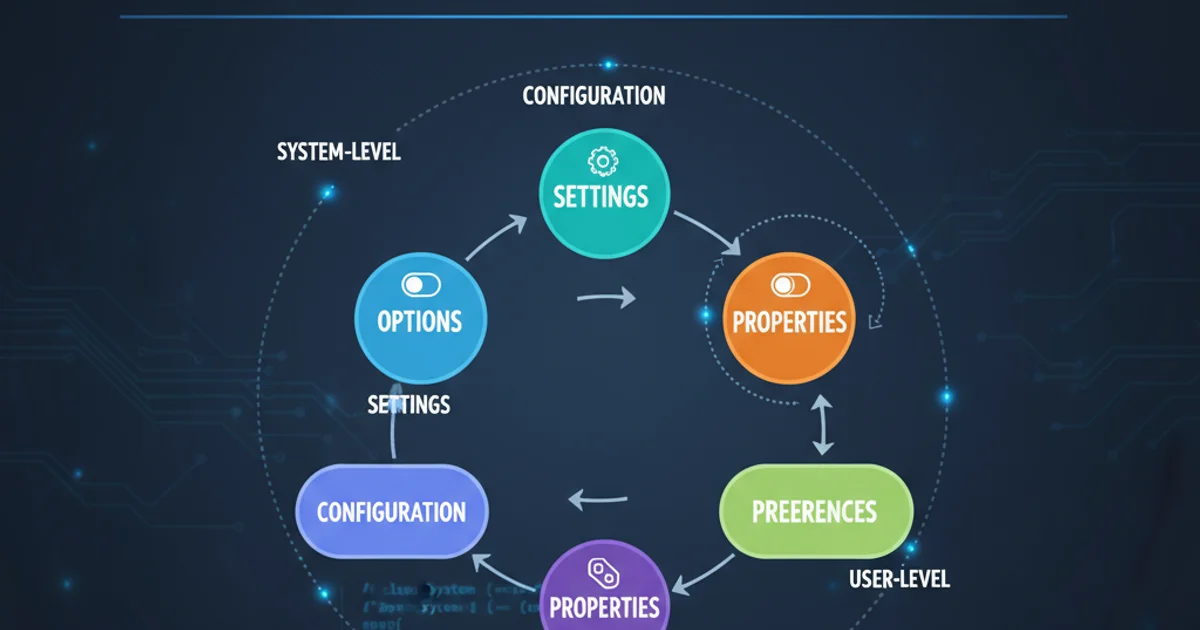Options, Settings, Properties, Configuration, Preferences — when and why?
Categories:
Options, Settings, Properties, Configuration, Preferences: Demystifying the Terminology

Navigate the often-confusing landscape of application customization terms. This article clarifies when and why to use 'options', 'settings', 'properties', 'configuration', and 'preferences' in software development and documentation.
In software development, we frequently encounter terms like 'options,' 'settings,' 'properties,' 'configuration,' and 'preferences.' While often used interchangeably, each term carries subtle nuances that, when understood, can lead to clearer communication, better system design, and more intuitive user interfaces. This article will break down these terms, providing context for their appropriate use and illustrating their relationships.
Understanding the Core Concepts
At their heart, all these terms refer to values that influence how a system or component behaves. The distinction often lies in their scope, mutability, target audience, and the level of impact they have. Let's explore each term individually.
Configuration: The Blueprint of the System
Configuration refers to the fundamental parameters that define how an application or system is set up to run. These are typically established at deployment or installation time and often require a restart or redeployment to change. Configuration values are usually critical for the system's operation and are managed by administrators or developers. They dictate things like database connection strings, server ports, logging levels, and external API endpoints. Changes to configuration often have system-wide implications.
database:
host: "localhost"
port: 5432
username: "admin"
password: "securepassword"
logging:
level: "INFO"
output_file: "/var/log/myapp.log"
Example of a YAML configuration file for a typical application.
Settings: Tailoring System Behavior
Settings are values that control the behavior or appearance of an application, often at a more granular level than configuration. They can be changed more frequently than configuration and might not always require a system restart. Settings can be global (affecting all users) or user-specific. Examples include default language, theme, notification preferences, or display resolution. While configuration defines how the system runs, settings define what the system does or how it looks within its operational boundaries.
flowchart TD
A[System Initialization] --> B(Load Configuration)
B --> C{Configuration Valid?}
C -->|Yes| D[System Operational]
D --> E(Load Global Settings)
E --> F(Load User Preferences/Settings)
F --> G[Application Running with Tailored Behavior]
C -->|No| H[Error: Invalid Configuration]Flowchart illustrating the loading order and impact of configuration and settings.
Properties: Describing an Object's State
In object-oriented programming, 'properties' are attributes that describe the state or characteristics of an object. They are intrinsic to the object itself and define its data. For example, a User object might have properties like id, name, email, and isActive. While these can sometimes be modified (setters), they are primarily about describing the object's current state rather than controlling system behavior or user experience. In some contexts, 'properties' can also refer to key-value pairs in a file (e.g., Java .properties files) that function similarly to settings or configuration.
public class User {
private String id;
private String name;
private String email;
private boolean isActive;
// Constructor, getters, and setters
public String getName() {
return name;
}
public void setActive(boolean active) {
isActive = active;
}
}
Java class demonstrating properties of a User object.
Options and Preferences: User-Centric Choices
'Options' and 'preferences' are largely synonymous and refer to choices made by an end-user to customize their personal experience with an application. These are typically stored per-user and can be changed directly through the user interface without affecting other users or requiring system restarts. Examples include theme color, font size, notification sounds, or default save locations. They empower the user to tailor the software to their individual needs and tastes.
Distinguishing Between Them
The key to distinguishing these terms lies in their scope, audience, and impact:
- Configuration: System-wide, developer/admin-managed, critical for operation, often requires restart/redeploy.
- Settings: Application-wide or user-specific, often managed by users/admins, affects behavior/appearance, may or may not require restart.
- Properties: Object-specific, describes state, managed programmatically.
- Options/Preferences: User-specific, user-managed, personalizes experience, rarely requires restart.
graph TD
A[Configuration] --> B(System-wide impact)
A --> C(Developer/Admin managed)
A --> D(Requires restart/redeploy)
E[Settings] --> F(Application-wide or User-specific)
E --> G(User/Admin managed)
E --> H(Affects behavior/appearance)
I[Properties] --> J(Object-specific)
I --> K(Describes state)
I --> L(Programmatically managed)
M[Options/Preferences] --> N(User-specific)
M --> O(User managed)
M --> P(Personalizes experience)
subgraph Scope
B
F
J
N
end
subgraph Management
C
G
K
O
end
subgraph Impact
D
H
L
P
endRelationship diagram highlighting the scope, management, and impact of each term.